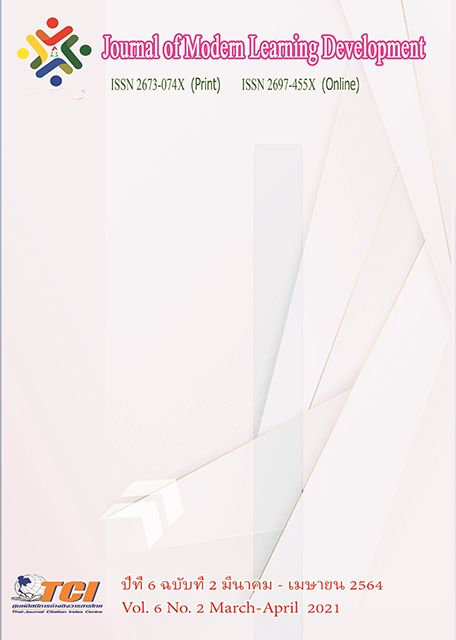The Development of Blended E-Learning Lessons of the Chemistry Laboratory Course for Secondary Level 4 in Science-Math Program Project, Yala Rajabhat University
Main Article Content
Abstract
Many studies show the blended e-learning approach that combines the traditional classroom-based and online modes of learning has an impact on the students’ learning achievement. This research aims to develop the blended e-learning model for the lessons of the Chemistry Laboratory course for the Secondary Level. This study examines 1) students’ learning achievement exploiting pretest-posttest comparison; 2) student’s chemistry laboratory skills; 3) student’s self-assessment of 21st-century skill and 4) Students’ satisfaction in Blended e-learning. The sample is the 28 students in secondary level 4 from Satree Islam Wittaya Foundation School, participating in the established project of Science and Mathematics program, Yala Rajabhat University (SMP-YRU). Research tools include the 5 blended e-learning lessons of the chemistry laboratory, learning achievement test, assessment of chemistry laboratory skills, self-report questionaries of 21st-century skill and the learning satisfaction questionnaire. The study was conducted in the second semester of the 2020 academic year, utilizing a blended mode of learning with a combination of e-learning and a science laboratory. The data were analyzed by paired samples t-test, percentage, mean and standard deviation.
The results of the study showed 1) a significant difference of the pre and post-test of learning achievement at a significant level of 0.1; 2) the majority of students (80%) gained chemistry laboratory skills at ‘Good’ level; 3) student’s self-assessment of 21st-century skill was significantly higher than regular classroom-based learning at a significance level of 0.01.; and 4) students’ satisfaction in Blended e-learning was at a ‘high’ level.
Findings show students achieved higher when exposed to Blended e-learning model, indicating that the blended e-learning model is the practical, effective instruction for teaching and learning in the chemistry laboratory. The recommendation is to further develop the blended e-learning mode of learning in other subject areas.
Article Details
References
กาญจนา สุมาลัย และคณะ. (2562). บทเรียนอีเลิร์นนิ่ง เรื่อง พื้นฐานไฟฟ้าในอาคารระดับ 1. วารสารครุศาสตร์อุตสาหกรรม. 18 (2), 189-196.
จารุวัจน์ สองเมือง และคณะ. (2559). การพัฒนาระบบอีเลิร์นนิ่งสำหรับการจัดการเรียนรู้ในโรงเรียนเอกชนสอนศาสนาอิสลาม. วารสารอิสลามศึกษา มหาวิทยาลัยสงขลานครินทร์. 7 (1), 60-73.
ซิดดิก อาลี และดลมนรรจน บากา. (2555). วิวัฒนาการการเรียนการสอนอิสลามศึกษาของโรงเรียนเอกชนสอนศาสนาอิสลามในสามจังหวัดชายแดนภาคใต้ของไทย. วารสาร อัล-นูล, 7 (13), 55-64.
ธีรวดี ถังคบุตร. (2561). การพัฒนารูปแบบการเรียนการสอนแบบผสมผสานด้วยการเรียนแบบโครงงานเป็นฐานเพื่อเพิ่มพูนความสามารถในการคิดอย่างมีวิจารณญาณสำหรับนิสิตปริญญาบัณฑิต. วารสารบัณฑิตศึกษา มหาวิทยาลัยราชภัฏวไลยอลงกรณ์ ในพระบรมราชูปถัมภ์. 12 (1), 61-69.
พฤทธิวรรณ ช่วงพิทักษ์ และคณะ. (2560). การพัฒนารูปแบบการจัดการเรียนรูปแบบห้องเรียนกลับทางร่วมกับการเรียนรู้เชิงรุกด้วยบทเรียนอีเลิร์นนิ่ง เรื่องการนําเสนอข้อค้นพบด้วยสื่อเทคโนโลยี ระดับมัธยมศึกษาตอนปลาย. วารสารครุศาสตร์อุตสาหกรรม. 16 (2), 89-96.
ไพฑูรย์ สินลารัตน์. (2557). หลักการและเทคนิคการสอนระดับอุดมศึกษา (พิมพ์ครั้งที่ 4). กรุงเทพมหานคร: จุฬาลงกรณ์มหาวิทยาลัย.
ภานุวัฒน์ ศรีไชยเลิศ และกฤช สินธนะกุล. (2560). การพัฒนาบทเรียนอีเลิร์นนิ่งแบบผสมผสานร่วมกับการจัดแผนการสอนแบบฐานสมรรถนะในรายวิชาการบริหารและการบริการอินเทอร์เน็ตสำหรับนักศึกษาสาขาคอพิวเตอร์ศึกษา. วารสารครุศาสตร์อุตสาหกรรม. 16 (3), 66-74.
มหาวิทยาลัยราชภัฏยะลา. กองนโยบายและแผน. (2563). เอกสารงบประมาณรายจ่ายประจำปีงบประมาณ พ.ศ. 2564. ยะลา: มหาวิทยาลัยราชภัฏยะลา..
วิจิตรา วงศ์ประทุม และทวี สระน้ำคำ. (2562). ผลการเรียนรู้แบบผสมผสานด้วยการเรียนแบบร่วมมือรูปแบบแบ่งกลุ่มผลสัมฤทธิ์เพื่อส่งเสริมการคิดวิเคราะห์สำหรับนักเรียนชั้นมัธยมศึกษาปีที่ 1. E-Journal of Education Studies, Burapha University. 1 (3), 32-42.
ศิริชัย นามบุรี. (2564). เว็บบล็อกโครงการจัดตั้งห้องเรียนพิเศษวิทยาศาสตร์และคณิตศาสตร์ (Science and Mathematics Program: Yala Rajabhat University: SMP-YRU). มหาวิทยาลัยราชภัฏยะลา. ออนไลน์. สืบค้นเมื่อ 15 มกราคม 2564. แหล่งที่มา : http://smp-yru.blogspot.com
ศุภักษร ฟองจางวาง และกอบสุข คงมนัส. (2559). การศึกษาองค์ประกอบของรูปแบบการเรียนการสอนแบบผสมผสานโดยใช้การเรียนรู้แบบร่วมมือ เรื่อง การเขียนโปรแกรมขั้นพื้นฐานด้วยภาษาจาวาสคริปต์ สำหรับนักเรียนชั้นมัธยมศึกษาปีที่ 3. Veridian E-Journal, Silpakorn University. 9 (3), 937-953.
สถาบันส่งเสริมการสอนวิทยาศาสตร์และและเทคโนโลยี (สสวท.). (2551). คู่มือครูรายวิชาเพิ่มเติมวิทยาศาสตร์และเทคโนโลยี มัธยมศึกษาปีที่ ๔ เล่ม ๑. สถาบัน: กรุงเทพฯ. ออนไลน์. สืบค้นเมื่อ 14 มกราคม 2564. แหล่งที่มา : http://www.scimath.org/e-books/8292/flippingbook
อวิรุทธ์ วิชัยศรี และคณะ. (2561). การพัฒนาอีเลิร์นนิงคอร์สแวร์แบบผสมผสาน เรื่อง เทคโนโลยีสารสนเทศสำหรับนักเรียนชั้นมัธยมศึกษาปีที่ 1 โรงเรียนดอนเมืองทหารอากาศบำรุง. วารสารการอาชีวะและเทคนิคศึกษา. 8 (15), 53-62.
สำนักงบประมาณของรัฐสภา. (2563). รายงานวิเคราะห์งบประมาณรายจ่ายประจำปีงบประมาณ พ.ศ. 2563 : กระทรวงการอุดมศึกษา วิทยาศาสตร์ วิจัย และนวัตกรรม. สำนักงานเลขาธิการสภาผู้แทนราษฎร. ออนไลน์. สืบค้นเมื่อ 15 มกราคม 2564. แหล่งที่มา : https://www.parliament.go.th/ ewtadmin/ewt/parbudget/download/article/article_20191213150940.pdf
สำนักงบประมาณของรัฐสภา. (2563b). รายงานวิเคราะห์งบประมาณรายจ่ายประจำปีงบประมาณ พ.ศ. 2563 : กองอำนวยการรักษาความมั่นคงภายในราชอาณาจักร (กอรมน.). สำนักงานเลขาธิการสภาผู้แทนราษฎร. ออนไลน์. สืบค้นเมื่อ 15 มกราคม 2564. แหล่งที่มา : https://www.parliament. go.th/ewtadmin/ewt/parbudget/download/article/article_20191213143914.pdf
Banyen, W., Viriyavejakul ,C. and Ratanaolarn, T. (2016). A Blended Learning Model for Learning Achievement Enhancement of Thai Undergraduate Students. International Journal of Emerging Technologies in Learning, 11 (4), 49-55.
Clover, I. (2020). Advantages and Disadvantages Of eLearning. Online. Retrieved January 11, 2021. From : https://elearningindustry.com/advantages-and-disadvantages-ofelearning.
Ispring. (2016). The ADDIE Model for E-Learning Instructional Design. Online. Retrieved January 11, 2021. from : https://www.ispringsolutions.com/blog/the-addie-model-for -e-learning-instructional-design
Johnson, S. M. (2020). E-Learning ADDIE Instructional Design. Online. Retrieved January 11, 2021. from : https://elearning.net/addie-instructional-design-model-overview-2
Kumar Basak, S., Wotto, M., and Bélanger, P. (2018). E-learning, M-learning and D-learning: Conceptual Definition and Comparative Analysis. E-Learning and Digital Media. 15 (4), 191–216.
Lalima and Dangwal, K. L. (2017). Blended Learning: An Innovative Approach. Universal Journal of Educational Research. 5 (1), 129-136.


